On the morning of November 19, 2005, thousands of panic-stricken Chinese poured through the crowded streets of Harbin in northeastern China–desperately trying to escape what would soon become a toxic ghost town. Frenzied crowds trampled women and children too slow to squeeze into the last of the cramped railway cars heading south before sundown. Two-bit criminals huddled in the shadows like ravenous turkey vultures, waiting to pick apart anything remotely valuable left behind. High-level hazmat teams in protective facemasks and rubber suits combed the riverbanks with the latest, most sophisticated chemical testing kits.
What was once a thriving industrial city, in a matter of hours mutated into an uninhabitable wasteland. While this certainly sounds like an intriguing premise for the next Mad Max movie, it’s actually a real-life scenario, which many believe to be a glimpse into the future.
On November 13, 2005, a lethal dose of highly toxic benzene was released into the Songhua River after an explosion at the China National Petroleum Company plant, hundreds of miles upstream in the Jilin province. Within minutes, a river of malignant water began flowing toward Harbin–one of China’s biggest cities…threatening to contaminate local water supplies. When the polluted water finally hit the city, 3.8 million residents in the center of Harbin had no water…period! And it couldn’t have happened in a worse place.
China which is undergoing a vast rural-to-urban population migration, is emblematic of the places where water has become scarce. It has the same amount of water as Canada but 100 times more people. Per-capita water reserves there are about a fourth of the global average according to experts.
Of its 669 cities, 440 regularly suffer moderate to critical water shortages, and according to the latest figures from the state environmental protection agency, an estimated 70% of Chinas main rivers and lakes are so polluted, the water is completely undrinkable. Fish can’t even live in over 31,000 miles of Chinese rivers. In fact, a number of hydrologysts, government officials and industrial leaders have declared water and waste pollution the single most serious issue facing China.
But it gets worse. Because this water crisis isn’t being monopolized by China.
History of Water: No More, No Less
There is no more water on the earth today than there was hundreds of millions of years ago. There is no less either. We can’t make it or destroy it.
And while our planet may be over 70% covered with water, less than 2% of it is freshwater. . . you know, the stuff we need to survive. Of that tiny 2%, some water is perpetually tied up as atmospheric moisture or as frozen saturated soil (permafrost) that we can never use. Put another way, if all the world’s water were in a one-gallon jug, fresh water wouldn’t account for even a teaspoon of it!
So if the amount of water has remained the same since the beginning of time, what’s the problem? The simple answer: us.
Or, more specifically, the amount of us–and what we’ve done to our water supply over the last few hundred years.
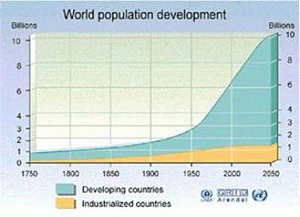 You see, water was first formed about 4.5 billion years ago. We’ve been around for only 60,000 years. But in that time, our population has exploded. And we’ve done it rather quickly. It took us all history to break the 1 billion-population barrier at the beginning of the 19th century. Since then, the world’s population has grown exponentially to over 6.5 billion. We now add about 75 people every 30 seconds. that amount of people, coupled with expanding industry, pollution, and associated problems have added to a Malthusian scenario– to say the least.
You see, water was first formed about 4.5 billion years ago. We’ve been around for only 60,000 years. But in that time, our population has exploded. And we’ve done it rather quickly. It took us all history to break the 1 billion-population barrier at the beginning of the 19th century. Since then, the world’s population has grown exponentially to over 6.5 billion. We now add about 75 people every 30 seconds. that amount of people, coupled with expanding industry, pollution, and associated problems have added to a Malthusian scenario– to say the least.
If nothing is done, by 2025 nearly two-thirds of the world’s population will be water stressed due to greater demands on freshwater resources by burgeoning human populations…the diminishing quality of existing water resources because of pollution…and the additional requirements of servicing our industrial and agricultural growth. That’s less than 20 years away .
This is Right Now: A Flood of Water Shortages in the Present Day
Water is unevenly distributed across the populated regions of the world. In fact, it’s downright ironic that two-thirds of the world’s population lives in areas that receive only one-quarter of the world’s annual rainfall, while the most water-rich areas of the world, such as the Amazon and Congo River Basins, are sparsely populated.
Some of the most densely populated regions of the world, such as the Mediterranean, the Middle East, India, and China will face severe water shortages in the coming decades. Even areas of the United States (particularly the southwest, Midwest, and Florida) are vulnerable to water shortages.
Around the world, countries are depleting their groundwater supplies faster than they can be naturally replenished–the equivalent of making constant withdrawals from a bank account without ever paying anything into it.
Nearly 450 million people in 29 countries currently face severe water shortages. By 2025, as many as 4 billion people could be water-stressed. According to the UN, water and sanitation deficits affect about 50 percent of all people in the developing world and lead to the deaths of 1.8 million children each year.
Today, all surface and ground freshwater resources in Jordan, Israel, the West Bank, Gaza, Cyprus, Malta and the Arabian Peninsula are fully used.
From India to Vietnam, millions of wells have been dug in an effort to service water-needy crops like rice and sugarcane. At the rate they are pumping water, underground supplies in some areas will be exhausted in five to ten years, and millions of Indians will see their farmland turned to desert.
In addition to overuse, warmer temperatures are increasing the evaporation of water from soil, exacerbating desertification that is currently occurring in over 100 nations. In fact, the United Nations estimates that more than 900 million people now live in regions that are at risk of desertification.
If that weren’t enough, it’s now possible to wade across Lake Chad–which was once one of the largest lakes in the world and thought to be the source of the Nile. Lake Chad used to cover an area of 400,000 square kilometers. With increased demand over the last 40 years, the lake now only covers about 1,500 square kilometers. And it’s predicted that this lake could entirely disappear in the next 90 years–turning a once lush oasis into desert, and depriving Chad, Cameroon, Niger, and Nigeria of a much needed source of water.
The Aral Sea is another prime example of water depletion. Under Vladimir Lenin, the Amu Darya and Syr Darya rivers–the sources of the Aral–were diverted to irrigate cotton crops on what otherwise would’ve been desert. The shoddy irrigation canals, built in the 1930s, sometimes leaked up to 70% of the water they carried–essentially wasting it, letting it seep into the desert floor. Once the fourth largest lake in the world, the Aral’s surface area has shrunk by 60% and its volume by 80%. . . and it’s still shrinking. The Aral isn’t just shrinking into oblivion; it’s now also extremely polluted due to a perilous mix of industrial waste, fertilizer runoff, and biological weapons dumping.
And the World’s lakes aren’t the only bodies of water in decline. Already major rivers, such as the Yangtze, Ganges, and Colorado, don’t flow to the sea for much of the year because of upstream withdrawals.
And this epidemic isn’t just going to be felt on an individual scale. It’s already affecting some businesses and, if not corrected, could have an adverse impact on the entire economy.
Already the Indian state of Kerala ordered PepsiCo and Coca-Cola bottling plants closed due to water shortages, costing the companies millions of dollars. Those plants were sucking wells dry and polluting the country’s groundwater and soil.
Disappearing Aquifers: Taking Out Without Putting Back In
Not only is the volume of rivers and lakes in decline, aquifers, one of our primary sources of water, are also being drained without being replenished. The Ogallala Aquifer, situated beneath South Dakota, Nebraska, Wyoming, Colorado, Kansas, Oklahoma, New Mexico, and Texas, is one of the world’s largest aquifers–bigger than the entire state of Montana. The Ogallala Formation ranges from a few feet to more than 1000 feet (300 m) and is generally greater in the northern plains.
The land above it–the breadbasket–is some of the most fertile land in the world. But that wasn’t always the case. . . remember the dust bowl?
Many of our nation’s successful farms and ranches are in areas that actually don’t get enough rain or surface water to support their operations. Instead, they rely heavily on pumping groundwater from the Ogallala for irrigation. This practice, in widespread use since the 1930s, is now showing its negative effects. In it’s early years, the Ogallala was thought to be inexhaustible. But now, because the rate of extraction exceeds the rate of recharge, water levels are rapidly decreasing.
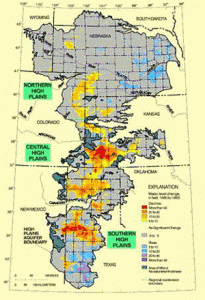 In some places, the water is declining at a rate of five feet per year. In others, the water is completely gone. And yet, we’re still extracting water at up to one hundred times the natural re- placement rate–taking out 14 million acre-feet a year, the equivalent of the Colorado River, without replacing it. Even optimistic predictions say that the Ogallala will be depleted by 2020. The chart to the left illustrates the situation.
In some places, the water is declining at a rate of five feet per year. In others, the water is completely gone. And yet, we’re still extracting water at up to one hundred times the natural re- placement rate–taking out 14 million acre-feet a year, the equivalent of the Colorado River, without replacing it. Even optimistic predictions say that the Ogallala will be depleted by 2020. The chart to the left illustrates the situation.
The Edwards Aquifer in west Texas is also facing a similar plight. And it gets worse. Many of our coastal aquifers, such as the Biscayne Aquifer near Miami and the New Jersey Coastal Plain aquifer, have problems with saltwater intrusion as a result of over-pumping.
It’s like digging a hole at the beach, only a little farther away. As we use the freshwater on top, saltwater begins to seep in from underneath, contaminating the entire aquifer.
In South America, the Guarani Aquifer is more stable, but has seen an increased American military presence in recent years. And though the White House won’t admit it, many speculate the US is trying to weasel its way into this giant source of groundwater–just as Muammar al-Qaddafi has done in Africa.
There, the Nubian Sandstone Aquifer System covers just over two million square kilometers under Sudan, Chad, Libya, and most of Egypt. But the construction of the Great Man-made River Project has all but monopolized this source of freshwater in favor of Libya. This pipeline–the largest civil engineering project ever undertaken–pumps more than 6.5 million cubic meters of water to Libyan cities everyday–equivalent to about 3,000 Olympic-sized pools. And the Nubian Aquifer is not being replenished at all. . . it’s mostly under desert! The water it contains has been there since the last ice age.
The World’s Superpower Doesn’t Even Have Enough
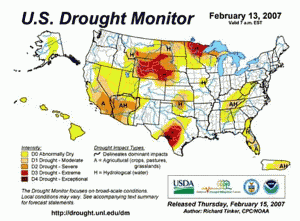
Right in our backyard, we’ll soon see our own sources of fresh water depleting at an alarming rate. There are already several regions facing severe and prolonged droughts.
And according to the Intergovernmental Panel on Climate Change, North America’s water supply is not immune to the effects of climate change, as the impact is expected to be felt from Florida and Texas to Alaska and Canada’s Northwest Territories.
In the next 30 years, Portland, Oregon, will require over 26 million additional cubic meters of water as a result of climate change and population growth, but the Columbia River’s summer supply will have dropped by an estimated 5 million cubic meters. And 40% of California’s water supply could be in danger of depletion in the next 15 years. Some experts already call California’s water system the most expensive welfare project in the world. Just wait and see the costs when the water really starts running out. Not to mention the numerous cities surrounding the Great Lakes could be water-scarce as those sources become more and more polluted.
Scenarios like this are being played out across the nation. In fact, the last time two states took up arms against each other was over water. Arizona governor, Benjamin Baker Moeur, sent 17 truckloads of troops to the Colorado River to stop California from “stealing” water during the construction of the Parker Dam.
Now I don’t mean to come off as some doom-and-gloomer here. In fact, I believe that this coming crisis will present a wealth of investment opportunities, given the amount of water we will need and the technologies that will emerge to meet that demand.
The Grim Details: How Demand is Already Severely Outpacing Supply
The world uses 2.1 trillion cubic meters of water every year–the equivalent of draining Lake Superior–the largest lake in the world–twice! That’s 17.5 million gallons of water every second. To put that in perspective–we use 41,000
gallons of oil every second.
But this is only half of what we should be using. You see, it’s generally accepted that 100 liters of water per day, or 36.5 cubic meters per year, is the minimum per person requirement for good health. An additional 730 cubic meters per year is need for agriculture, industry, and energy production for each person. That brings the minimum accepted per capita water requirement to 766.5 cubic meters. So with about 6.5 billion people on the planet, we should be using nearly 4.1 trillion cubic meters of water per year–minimum.
Yet this is simply not the case. Here’s why.
• North Americans use 1,280 cubic meters
• Europeans and Australians use 694 cubic meters
• Asians use 535 cubic meters
• South Americans use 311 cubic meters
• Africans use 186 cubic meters
These numbers paint a pretty grim picture. North America is exceeding the minimum per person requirement by over two thirds. Europe, Australia, and Asia are at least in the ballpark, while South America and Africa aren’t even close.
Boiled down to its simplest implications, this scenario shows 1) that we only have enough fresh water capacity to support about half of world demand and 2) nearly 25% of the world’s population (1.5 billion) lack adequate water for drinking and sanitation.
Demand is simply already severely outpacing supply. And if that weren’t bad enough, 20 percent more water than is now available will be needed to feed the additional three billion people who will be alive by 2025.
So what are we going to do about it?
Conserve, Recycle, and Profit
Unlike with oil, no technological innovation can ever replace water. So, the way I see it, there are two ways to capitalize on the water-supply market.
The first–and most obvious–is to invest in water through utilities. And this might not be a bad way to go. In fact, in any random five-year period during the last 25 years, water utilities outperformed all other leading industry groups on a total return basis.
But it gets even better. You see, only about 10% of water utilities are publicly traded, with 90% still owned by state and local governments. And that 90% is currently facing vast expenditures to expand their crumbling infrastructure so they can keep up with rising demand.
In the US alone there are serious problems with collapsed storm sewers, storm and wastewater runoff, and an estimated 20% loss from leakage in drinking water systems. The nation has 800,000 miles of water pipes and 500,000 miles of sewer pipes. Generally, these pipes are supposed to last fifty years. The most comprehensive research to date suggests that the average age of water infrastructure pipes in the US is 43 years.
Just this single piece of data implies that nearly the entire water pipeline system in the US will soon have to be replaced. To overcome these obstacles, an investment upwards of $1 trillion will need to be made in the next twenty years. That breaks down to over a 150% annual increase over current spending amounts of $60 billion annually.
This money would go to overhauling the water and wastewater infrastructure, as well as to increased operations and maintenance costs, and would result in increased efficiency due to due non-leaking pipes, upgraded facilities, and the installation of new technology.
To date, water and sewer bills, taxes, and private business foot the cost for most of the funds needed to build, operate, and maintain water and wastewater systems.
But those sources alone are not meeting the total current amount needed, let alone the increase that will be needed in coming years. To meet future funding requirements, private firms in the industry will have to play a key role. The pressure of a competitive market, coupled with the introduction of new technology, will help ease the pain of an emerging funding gap.
Because right now the majority of water utilities are owned by states and municipalities, to help generate more funding, many of these utilities are going public. So much so that Lehman Brothers believes the number of people served globally by investor-owned water companies is expected to rise 500% over the next 10 years.
With the amount of money that has to come to this sector, investment opportunities will surely abound. And with demand for water constantly rising, you can bet those now publicly traded companies will be charging a premium for their services.
Check out York Water Co. (NASDAQ: YORW) since it listed in May 1999:
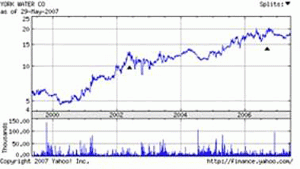 That’s roughly a 280% gain, far outperforming the Dow’s modest 24% for the same span of time– even with all its recent record-breaking closes.
That’s roughly a 280% gain, far outperforming the Dow’s modest 24% for the same span of time– even with all its recent record-breaking closes.
And if the demand for water continues to rise at its current pace, utilities aren’t the only ones that stand to make some money. So will companies I’ve come to call the “water works”–companies that design and manufacture specialized parts, monitoring devices, and wastewater recycling technology.
You see, if water utilities are going to continue to provide fresh water, they will need more than a little help from these specialized companies. Without those solutions–and the companies that provide them–water utilities would be hung out to dry. The two are inextricably connected.
Take a look at water purification and groundwater treatment company Calgon Carbon Corp. (NYSE: CCC). Over the past six months, they’ve absolutely exploded along with the chatter about coming water shortages.
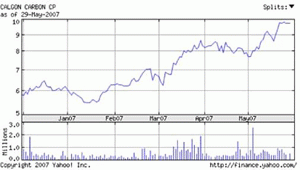
These companies are going to make money because no matter how much it costs, there’s no substitute for water–period. The laws of supply and demand don’t apply here. Only demand rises.
Worth It’s Weight in Salt
Desalination technology, among others, will play a huge role in helping to avoid the coming water crisis. But, as of yet, desalination is not cost-competitive with other tactics such as water importation–though the price has declined 60% in the last 15 years, and continues to do so.
Desalinating one acre-foot (326,000 gallons) costs about $800, while importing that same amount costs about $500. In the near future these price points will intersect, making it more economically viable to use this technology. When that happens, we’ll see desalination grow much faster than it already is. To date, there are already 11,000 desalination facilities in 120 countries worldwide, with a capacity of 4 billion gallons daily, or about 1.5 trillion gallons annually.
And while that may sound impressive, 1.5 trillion gallons is only .26% of world demand! Plus, most of these facilities are in the Middle East, with only 1,200 in the US–making this truly a young industry with plenty of investment opportunity. There will be plenty more sites being built and coming online, especially in water-scarce coastal regions like California and Florida. We’ll see most of this opportunity in reverse osmosis, and the companies that design and manufacture the complex membranes needed to make this process a success.
Further Downstream
The water issue is indeed pervasive, tying together many other world problems like poverty, hunger, ecosystem destruction, desertification, climate change, the economy, and even world peace. A shortage of our most precious resource will certainly warrant a response from world governments and free markets unlike we’ve ever seen.
But there is certainly an upside, as is the case with most problems that have faced civilization. With the right knowledge and insight it will be possible to make the solutions to this issue not only beneficial for human existence, but also for individual investors.
By staying ahead of the curve and finding companies with good solutions early, savvy investors stand to profit handsomely from a variety of water-related technologies.
EXCERPTED FROM:
Green Chip Review, Copyright © 2007, Angel Publishing LLC, P.O. Box 84905, Phoenix, AZ 85071. All rights reserved. No statement or expression of opinion, or any other matter herein, directly or indirectly, is an offer or the solicitation of an offer to buy or sell the securities or financial instruments mentioned. While we believe the sources of information to be reliable, we in no way represent or guarantee the accuracy of the statements made herein. Green Chip Review does not provide individual investment counseling, act as an investment advisor, or individually advocate the purchase or sale of any security or investment. The publisher, editors and consultants of Angel Publishing may actively trade in the investments discussed in this newsletter. They may have substantial positions in the securities recommended and may increase or decrease such positions without notice. Neither the publisher nor the editors are registered investment advisors. Subscribers should not view this publication as offering personalized legal or investment counseling. Investments recommended in this publication should be made only after consulting with your investment advisor and only after reviewing the prospectus or financial statements of the company in question. Unauthorized reproduction of this newsletter or its contents by Xerography, fac- simile, or any other means is illegal and punishable by law.
